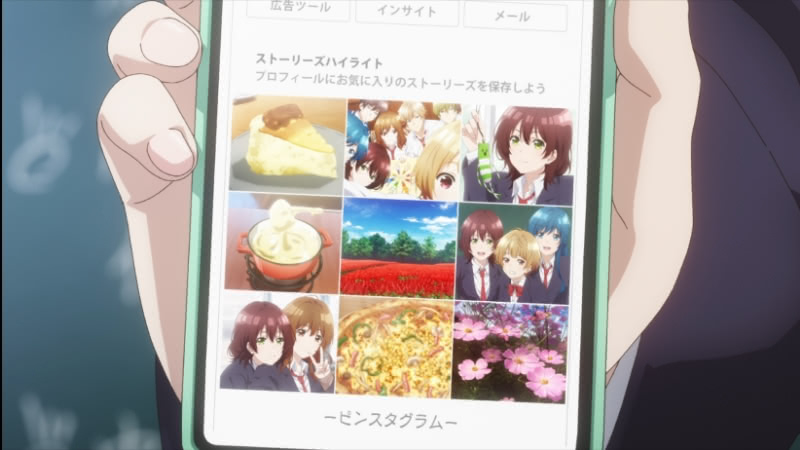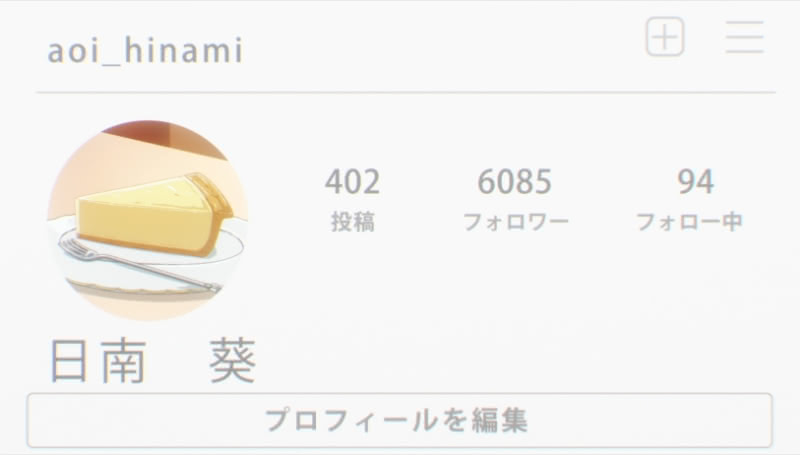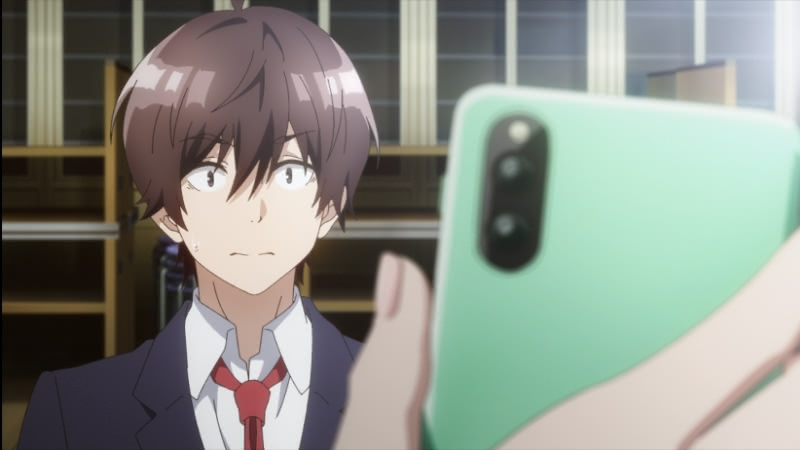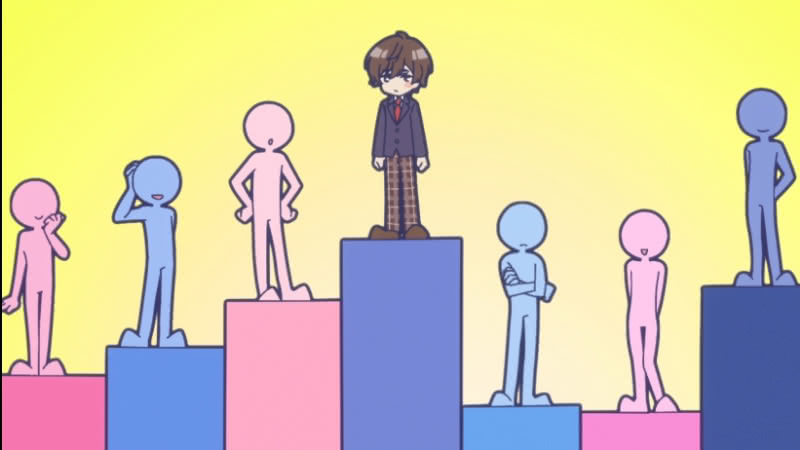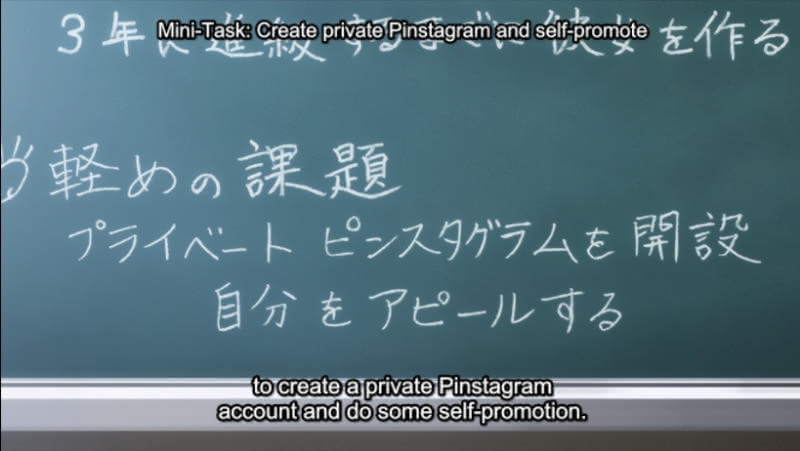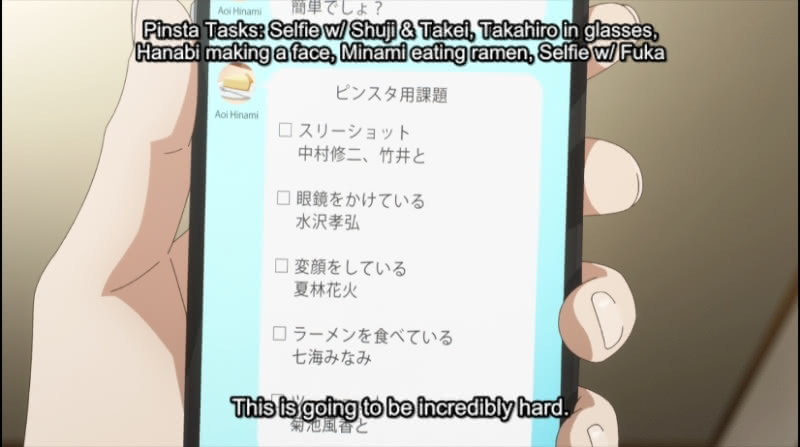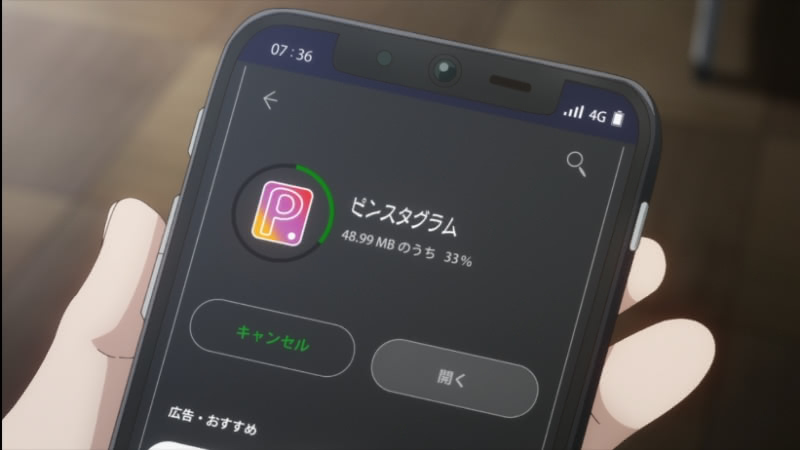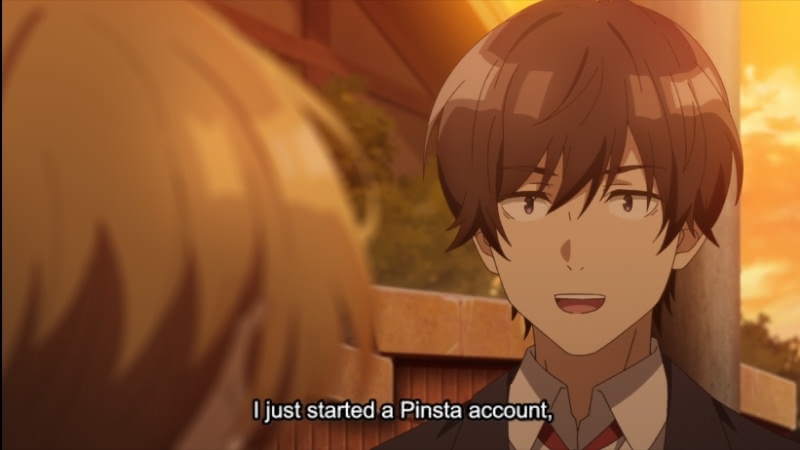Last year, I wrote an article jokingly suggesting that an anime character (Akane in My Love Story With Yamada-kun at Lv999) was making a mistake by running Windows instead of Linux and that she could fix her life problems my making the switch. Today, I tackle an even more serious anime-tech character flaw in the same vein: The second season use by Bottom-tier Character Tomozaki-kun’s of proprietary, data-grabbing, social media. Anime promotion of Pinstagram is dark indeed, not least because the made up name could be read as inadvertently promoting two bad social media platforms at once. After introducing the problem and making jokes, I will offer a more serious take on the series’ use of a subpar proprietary social media platform.
Un-Spoiler Notice
I will discuss a task that Hinami gives Tomozaki in episodes 6 and 7 of the second season of the anime. I will not discuss any major plot points but the nature of Hinami’s task is in line with tasks she gives him throughout the first season. The article is written in a way to be intelligible to people who have not watched the series and do not intend to watch the series and it poses no meaningful spoiler danger to people who may plan to watch the series in the future. If you are interested in the series generally, you can read my full review of season 1.
Brief Introduction to Bottom-tier Character Tomozaki-kun
I have been watching the second season of an anime series called Bottom-tier Character Tomozaki-kun. I wrote a general overview in my review of the first season, so I will refer readers there to learn about the series in more detail. For the purpose of this article, it suffices to say that the central relationship in the story is between Fumiya Tomozaki and Aoi Hinami. Fumiya Tomozaki begins the series as an anti-social high school boy who spends all of his time with a game called Attack Family, which is definitely not Super Smash Brothers (perish the thought). Aoi Hinami, the most popular girl in school, takes Tomozaki under her wing and gives him lessons in how to become popular after discovering that he was her great online rival in the video game that is definitely not Super Smash Brothers. Tomozaki (the character) has come a long way by the mid-way point of season two and is now relatively well-liked among his peers and mostly capable of handling social situations without too much hand-holding.
I have had some issues with season two through 7 episodes, but I will set those aside for a review when the season is completed. Despite its flaws, the series does have a positive message at its heart. Tomozaki has a warped worldview when we first meet him at the beginning of season one. He takes no care of his appearance or presentation and preemptively blames others for his own shortcomings despite not having put any effort into engaging with the world. Hinami’s advice is largely superficial, but she is proven to be correct that Tomozaki would benefit from taking care of his appearance and making the effort to get to know people. Tomozaki does benefit greatly from Hinami’s lessons, and that puts him in a place where he can begin to question Hinami’s worldview – which can charitably be described as unhealthily superficial. Tomozaki’s growth manifests in his using what he learns from Hinami (e.g., caring for his appearance, learning how to interact with people, making an effort to be part of the group) to find meaningful enjoyment in life instead of succeeding in appearances for its own sake.
But despite the open disagreements between Tomozaki and Hinami, Tomozaki still receives lessons and tasks from Hinami every morning. There is much to criticize about Hinami, but I was never more disturbed than when she compelled Tomozaki to install a proprietary social media app on his phone for a new task.
(The “never more disturbed” language should generate a few Shinbo-esque head-tilts from people who have watched the whole series thus far.)
Hinami’s S2 Episode 6 Assignment
After Hinami and Tomozaki spend much of their two episode counseling sessions disagreeing about things beyond the scope of our article, Hinami reveals her new assignment for Tomozaki. He will create a “Pinstagram” account.
Anime tends to avoid using corporate names. Here, they combined the names of two terrible proprietary social media services into one to create the fictional Pinstagram. However, as you can see from the above screenshot, Pinstagram is definitely not Instagram in the same way that the anime’s Attack Families is definitely not Super Smash Brothers. There is no reference to any Pinterest-like functionality, so we can proceed with the understanding that Pistagram is absolutely not Instagram.
Hinami made sure that Tomozaki saw that she has 6,085 followers, 5,127 of which were bots (I made the last part up).
(Note: I had to look up a picture of an Instagram account because I wanted to double check that the “6085” number referred to followers. Sure enough, Crunchyroll’s translation was correct.)
Tomozaki was initially skeptical of the idea of him having a Pinstagram account. While he had made great social progress by the point this plot line is introduced, he is not far removed from having been a disheveled loner who rose to the top of the Super Smash Brothers (I mean Attack Families) online leader-board alone and with a dead look in his eyes (now he stays ahead of Hinami without the dead eyes). We see that he is floored by the fact that Hinami has a few thousand followers.
Sadly, despite how much Tomozaki has grown, it does not occur to him to ask if Hinami is really alright with being a product for online advertisers instead of owning her online presence. The kid needs some work.
But I digress (for now).
Hinami explains that Tomozaki can use this Pinstagram account to further increase his social standing in school.
(Hinami clearly has some additional reasons for giving Tomozaki this task, but those are beyond the scope of the instant article.)
Seeing that Tomozaki will not resist this assignment like he had partially resisted the assignment she gave him right before introducing the Pinstagram idea, she formalized his task on the blackboard.
Tomozaki would be required to create a private Pinstagram account and use it to promote himself. I have some thoughts here, but I will set those aside for the moment.
Tomozaki is not confident that he can do this successfully, but he made it as far as he has by believing in Hinami’s assignments and doing his best – so why stop now? Unlike a few assignments they had issues with going back to the latter stages of season 1, nothing about the Pinstagram idea implicated Tomozaki’s tension with Hinami. Of course, had Tomozaki been thinking more clearly about his digital identity, he would have raised immediate objections. But again, we are getting there.
Hinami saved Tomozaki’s specific task list for a text message after they had both gone home.
Here, we can see start to see Hinami’s real objective. She directed Tomozaki to complete the following objectives and post them to his private Instagram (I mean Pinstagram):
- Take a selfie with Shuji and Takei;
- Take a photo of Takahiro in glasses;
- Take a photo of Hinabi making a face;
- Take a photo of Minami eating ramen; and
- Take a selfie with Fuka.
Separate from the ad-filled proprietary social media, what is actually being asked of Tomozaki is similar to many assignments throughout the series. Hinami pushes him to go out of his comfort zone socially, and in so doing he usually finds a way to complete the task and gains some confidence. While Hinami does push Tomozaki to do superficial things, the skills he picked up along the way have benefited him – even granting quibbles with one task or another. But we are not ready for all of my quibbles yet.
After Tomozaki has completed one of the five photo tasks he was given by taking a blurry photo (much to Hinami’s chagrin), Hinami shows him how to install proprietary spyware on his phone. Great job Hinami!
(I looked up the current APK size and saw that it is 60 MB. Maybe Hinami found a lite version or perhaps it weighed less a few years ago.)
I will not get into how Tomozaki goes about completing his specific photo quests, other than to note that some of Hinami’s peripheral reasons for giving the assignment become clear and Tomozaki may have inadvertently lost his sense of direction at certain points. But below you will find one screenshot of him moving to check one of the boxes on his list.
Now let us get to the problems.
Hinami’s Proprietary Social Media Crime
Tomozaki did not have Instagram (I am dispensing with the Pinstagram fiction) prior to being prodded by Hinami. We saw through the first 19.5 episodes of the series that he made great social progress without needing to join a big tech proprietary social media platform. Hinami is often a difficult character to like.. Nevertheless it is clear from the series that, flaws and all, she was the person Tomozaki needed to guide him on a journey of self-improvement, and it is only because of what he has gleaned from Hinami that he has the perspective to question some of the warped, self-defeating aspects of her worldview. For that reason, Hinami is entitled to some deference with respect to Tomozaki. But her ushering him onto Instagram and installing a terrible spyware app on his phone is wrong. He did not need it. His life will be worse for it. Bad!
I questioned the protagonist of Yamada-kun for using Windows over Linux. Using Instagram at all is far worse.
Hinami’s putting Tomozaki into awkward social situations is not unusual, and I alluded to the fact that her motivation in the some of the specific tasks is connected to another one of her projects that is beyond our scope. But bringing Instagram into the equation runs contrary to the series’ generally positive message. Firstly, it pushes Tomozaki to look at his tasks as performative instead of making a genuine effort to engage with his friends. Secondly, Hinami’s associating self-promotion with social media outsources Tomozaki’s growth to an amorphous ad platform, which is subpar. Prior to Instagram entering the occasion, Tomozaki’s growth was characterized by his real-world interactions with his peers. Now he is supposed to become more popular by showing the kinds of photos he can post to his “private” Instagram profile (“private” Instagram only does so much good when your data is still being used for advertising).
I will give Tomozaki credit if it actually tackles Hinami’s Instagram usage head-on in future episodes, although I am not optimistic that it will (I think it will focus on the effects of how Tomozaki completes his tasks instead of the social media component). I specifically want the series to acknowledge in some way that Himami’s assignment was given in error. While I have my doubts that it will specifically look at the social media component of the issue, it is not impossible that it will based on what I have seen thus far (note I have not read the novels). The role of Instagram pulls Tomozaki away from the end he is trying to achieve by implementing Hinami’s advice toward while not even necessarily being in line with Hinami’s goals for him.
A Matter of Perspective
We must grant from the outset that Hinami sees no problem with Instagram. The light novel series began in 2016. If we assume for the sake of argument that the series – which has an ordinary, contemporary Japan setting – takes place in 2016 or thereabout, we can infer that Hinami and the rest of the cast were born somewhere in the neighborhood of 1999-2000. In an essay that I wrote in 2020 arguing that adults should not share photos of children on social media, I made the following observation about a friend from high school who was uncomfortable with her parents praising her to their friends:
Although she did use social media and shared information about herself online, her sense of personal autonomy and view of the world was still influenced by having gone through much of her childhood at a time before the internet was ubiquitous … Today, many, if not most, children do not have that frame of reference. A child whose every baby picture and subsequent major life event is immortalized on Facebook, and who may have had a tablet before he or she could walk and talk simultaneously, never had the opportunity to contemplate personal privacy in the way that my classmate did.
I am old enough to have received my first video game console, a Sega Genesis, in 1994. It should suffice to say that granting my assumptions about when Tomozaki is intended to take place, I am meaningfully older than its cast. Social media was not a subject among my peers until I was in high school, and even then it was not a significant topic (I recall Facebook having taken hold right around when I graduated). (Note: I am writing this from an American perspective granting that I do not have a frame of reference for the growth of social media in Japanese schools.) But if you were born around 1999 and 2000, you will likely lack a strong frame of reference for a world without social media. For Hinami and her peers, it is natural and expected to have an Instagram account and share personal photos of themselves and their friends for the low price of giving their data to Mark Zuckerberg and advertisers. From this perspective, one can see why Hinami thinks that Tomozaki by joining the proprietary social media hive-mind he will take a natural step on his journey from loner to normie – separate and apart from the other motivations she had for putting him in specific social situations with his peers. Promoting oneself online is what the cool kids do, apparently.
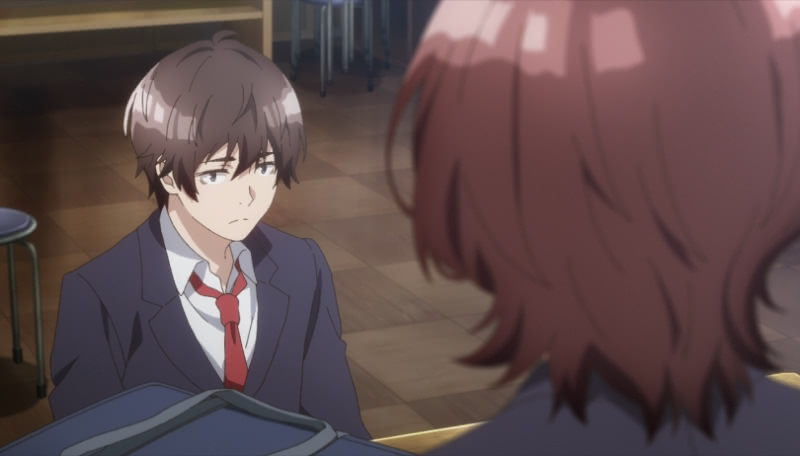
The reason Hinami’s plan makes perfect sense to her and the reason that Tomozaki does not question it beyond being shocked that Hinami thinks he is capable of promoting himself online using the cool kids app is because nothing in their life experience would lead them to question these assumptions. While Hinami prides herself on being able to manipulate and control the mood and she tries to push Tomozaki to put himself out there and change the flow of things, it does not occur to either one of them that (A) Tomozaki may be better off not having an Instagram account; and (B) there are other ways for him to increase his social standing and put himself out there that do not rely on a silly commercial social media platform (I will note B was demonstrated often in the series prior to the introduction of the Instagram arc). Hinami settled on Instagram because it is simply what social climbers already use.
Conclusion
I thought about suggesting alternatives for Hinami and Tomozaki. To be sure, assuming arguendo the same scenario occurred today, Hinami could have set Tomozaki up with a Pixelfed, Mastodon, or Misskey account or had him create a free WordPress.com site to post his daily photos and notes. But in the end, there are two issues. Firstly, Instagram did genuinely make the most sense for Hinami’s use-case. Secondly, when Instagram makes the most sense for one’s use-case, the use-case itself is most likely the problem. Hinami had previously given Tomozaki many difficult, awkward social assignments. He often questioned them, but trusted her and struggled through them. It is thanks in large part to these assignments that Tomozaki has enough friends for Hinami to have come up with the Instagram idea. But the Instagram assignment is fundamentally based on performing life, not living it – and that is a Hinami approach to winning instead of what Tomozaki is searching for.
This ties into my critique of many open source alternatives to big tech social media. I argued that they err by trying to replicate the user interface and functionality of their big tech inspirations as if the only problems with big tech social media are centralization and advertising. To be sure, those are problems, but many problems come from the structure of the big tech social media itself and the sort of posting it incentivizes. (I will note that I think this is less of an issue with Pixelfed, which very much draws inspiration from Instagram, than with the many attempts to replicate X’s functionality.) Hinami’s assignment highlights the issue from a different perspective – the tendency of big tech, data-vacuuming social media to affect how people live (or perform) life and relate to one another in the real world rather than online.
I conclude my specious article with a practical take-away. If someone determines that Facebook, Instagram, TikTok (which should be banned) or the like is the means to a non-business end, he or she should reassess the end before reassessing the means.
